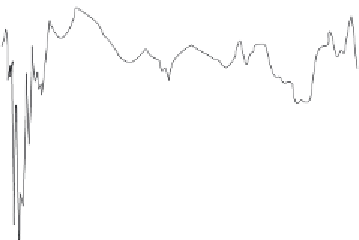Environmental Engineering Reference
In-Depth Information
%T
%T
4000
3000
2000
Wavenumber [cm
-1
]
1000
400
4000
3000
2000
Wavenumber [cm
-1
]
1000
400
a)
b)
99
100
1
12
20
21
80
13
17
22
16
14
95
3
9
1
11
2
15
60
18 19
22
%T
%T
29
23
21
25
24
41
26
27
39
8
5
6
40
16
19
20
13
1
15
11
17
46
90
30
3
12
20
8
40
4
44
45
4
38
2
10
9
7
42
1
6
4
31
32
3334
35
36
18
37
0
87
28
1000
5
4000
3000
2000
Wavenumber [cm
-1
]
400
4000
3000
2000
Wavenumber [cm
-1
]
1000
400
c)
d)
Figure 1.3
FTIR of a) carrier bag collected at the beach (the methylene stretches
at 2,932 and 2,850 cm
-1
and the methylene deformations at 1,464 and 719 cm
-1
are characteristic of PE); b) tea cup collected at the beach (peaks at 2,980 and
2,819 cm
-1
are methylene stretches, peaks at 1,456 and 1,370 cm
-1
are because of
aromatic ring bending frequencies and peaks at 3,192 and 3,082 cm
-1
are because
of aromatic C−H stretching and these indicate that the teacup is PS); c) biscuit
wrapper (bands at 2,952, 1,726, 1,461, 1,406, 1,350 and 1,097 cm
−1
are assigned
to polyester blend. The bands at 1,726 and 1,097 cm
−1
are attributed to C=O and
C-O stretching vibrations, respectively, and the remaining bands are assigned to
C-C and C-H vibrations. So the two former bands indicate the presence of ester
groups and the two latter bands indicate the presence of an ethylene group, thus,
this could be a blend of LDPE and polyester); and d) cushion foam (peaks at
3,625 and 1,738 cm
-1
indicate N-H stretching
and the carbonyl of an amide bond,
respectively, and the band at 1,004 cm
-1
is attributed to C-O stretching. These
results suggest that the foam is PU







